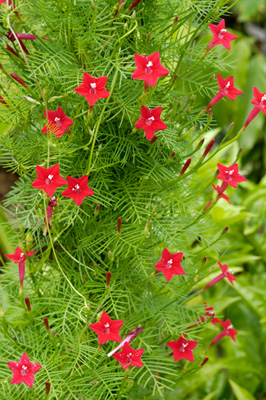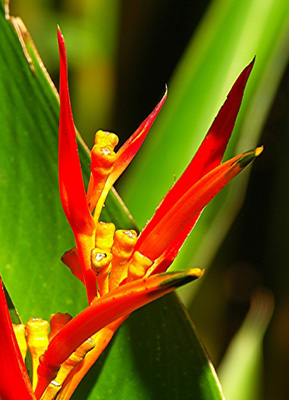FTC Disclosure: If you make a purchase via a link on this site, We may receive a small commission on the transaction - at no added cost to you. Thank you!
Hummingbird Flower
Planting Zones
Here are the hummingbird flower planting zones 1 through 10 listed below with our easy to follow step by step guide to help with your garden planning.
Compare minimum temperatures to choose the right zone for your location. You will find a list of flowers and plants that will attract hummingbirds and grow in your zone.
How to Choose the Right Hummingbird Flowers for Your Zone:
Step 1.
Find your planting zone in the "Hardiness Zone Map"below or insert your zip code in the box of our "Find My Hardiness Zone" finder.
Step 2.
Below on this page you will find hummingbird attracting flowers that will grow in your zone.
Here are quick links that will take you below to find the plants in your zone:
Step 3.
Jot down the flowers you prefer for your Hummingbird Garden.
Step 4.
Visit our "Hummingbird Flower Shop" to order your flowers.
Mouse over (Tap on Mobile) image to Zoom/Magnify

Print the Planting Zones for
Hummingbird Flowers
Find My Hardiness Zone
(Enter your zip code)
Invalid Zip Code. Please try again.
USE MAP ONLY AS A GUIDE
Many variables determine a plants true adaptability including rainfall, humidity, soil, elevation, light, age and cultural maintenance.
ZONE MAP does not determine plants adaptability to given locality but indicates minimum expected temperatures for region and how it relates to a plant's chances of survival at that temperature.
We have listed flowering plants for hummingbirds according to Zones of Hardiness.
However, on a small map such as this, it is difficult to show all of the local variations and climactic changes within each zone.
Most nurserymen agree that zone designations for plants are approximate.
Many plants can be grown in one zone "colder" than rated by simply placing in a protected location or by proper winter care (such as mulching).
A southern exposure protected from winds will often allow one to plant specimens normally expected to grow only in warmer climates.
Many houses have areas protected by two sides of an "L" and that protected spot will act ten degrees warmer than the open yard, even in the coldest weather.
Do not be discouraged from attempting to grow a "Zone 5" plant in "Zone 4", or a "Zone 3" plant in "Zone 2". Just try to think of a spot in your landscape that is a little more protected.
Hummingbird Flower Planting Zone-1:
Minimum temperatures: Below –50 F (Below – 46 C)
Zone 1 includes the coldest parts of North America. They are the
extreme northern parts of Canada, parts of the Yukon Territory, Alberta,
and Saskatchewan, interior Alaska, and parts of the Aleutians and
Kodiak Island.
Only the hardiest plants can survive in these areas.
These plants survive the cold temperatures and short growing seasons and they are enjoyed by hummingbirds.
| COMMON NAME | BOTANICAL NAME | ZONE |
|---|---|---|
| Impatiens | Impatiens | 1-11 |
| Jewelweed | Impatiens | 1-11 |
| Mexican Sunflower | Tithonia rotundifolia | 1-11 |
| Nasturtiums | Tropaeolum | 1-11 |
| Red Sage | Salvia splendens | 1-11 |
| Scarlet runnerbean | Phaseolus coccineus | 1-11 |
| Scarlet sage | Salvia coccinea | 1-11 |
| Snapdragon | Antirrhinum majus | 1-11 |
| Texas sage | Salvia coccinea | 1-11 |
| Tree tobacco | Nicotiana glauca | 1-11 |
| Zinnia | Zinnia | 1-11 |
Hummingbird Flower Planting Zone-2:
Minimum temperatures: Below –50 to -40 F (Below – 46 to -40 C)
Zone 2 is the southern geographical area of Zone 1 which is the coldest parts of North America.
They are the extreme northern parts of Canada, parts of the Yukon Territory, Alberta, and Saskatchewan, interior Alaska, and parts of the Aleutians and Kodiak Island.
Only the hardiest plants can survive in these areas.
These plants survive the cold temperatures and short growing seasons and they are enjoyed by hummingbirds.
| COMMON NAME | BOTANICAL NAME | ZONE |
|---|---|---|
| Obedient plant | Physostegia virginiana | 2-9 |
| Morning glory | Ipomoea coccinea | 2-9 |
| Cardinal flower | Lobelia | 2-8 |
These plants can be used in the southern area of Zone 1 in addition to all of the plants listed in the zone 1 table.
Hummingbird Flower Planting Zone-3:
Mimimun Temperature: -40 to -30 F (-40 to -34 C)
Zone 3 stretches along the Canada-United States border in North America.
It includes such cities as International Falls, Minnesota and Sydney, Montana.
This gardening zone has cold winters and warm to hot summers.
There is a 2 to 4 month gardening season.
| COMMON NAME | BOTANICAL NAME | ZONE |
|---|---|---|
| Bleeding heart | Dicentra spectabilis | 3-8 |
| Columbines | Aquilegia | 3-9 |
| Coral bells | Heuchera | 3-8 |
| Day lily | Hemerocallis | 3-8 |
| Delphinium | Delphinium | 3-7 |
| Fireweed | Epilobium augustifolium | 3-9 |
| Gay feather | Liatris | 3-8 |
| Hollyhocks | Alcea rosea | 3-7 |
| Hosta | Hosta | 3-8 |
| Larkspur | Delphinium | 3-7 |
| Liatris | Liatris | 3-8 |
| Lilac | Syringa vulgaris | 3-8 |
| Plaintain | Lily | 3-8 |
These plants can be used in Zone 3 in addition to all of the plants listed in zone 1 and zone 2.
Hummingbird Flower Planting Zone-4:
Minimum temperatures: -30 to –20 F (-34 to –29 C)
Zone 4 includes the upper portions of Minnesota, Nebraska, and Montana.
A
wide variety of perennials and herbaceous plants grow here because of
the nearly constant snow cover with it’s insulating effect from the
cold.
In spite of the cold winters, summers can sometimes be very hot.
| COMMON NAME | BOTANICAL NAME | ZONE |
|---|---|---|
| Bee Balm | Monarda | 4-8 |
| Bishop’s Hat | Epimedium grandiflorum | 4-9 |
| Coral Honeysuckle | Lonicera sempervirens | 4-10 |
| Foxglove | Digitalis | 4-8 |
| Giant Hummingbird Mint | Agastache barberi | 4-8 |
| Honeysuckle | Lonicera | 4-10 |
| Horsemint | Monarda fistulosa | 4-8 |
| Ipomopsis | Ipomopsis | 4-11 |
| Morning Glory | Ipomoea | 4-7 |
| Penstemon | Penstemon | 4-7 |
| Phlox | Phlox | 4-8 |
| Rhododendrom | Rhododendrom | 4-11 |
| Skyrocket | Ipomopsos | 4-11 |
| Trumpet vine | Campsis radicans | 4-9 |
These plants can be used in Zone 4 in addition to all of the plants listed in zones 1, 2 and 3.
Hummingbird Flower Planting Zone-5:
Minimum temperatures: -20 to -10 F (-29 to -23 C)
Zone 5 includes the states of Iowa and the upper portions of Illinois and Missouri.
You can grow a large variety of plants in this zone.

| COMMON NAME | BOTANICAL NAME | ZONE |
|---|---|---|
| Butterfly bush | Buddleia | 5-9 |
| Comfrey | Symphytum | 5-10 |
| Crocosmia lucifer | Crocosmia | 5-10 |
| Double Bubblemint | Agastache cana | 5-9 |
| Gladiolus | Gladiolus | 5-8 |
| Red hot poker | Kniphofia vuaria | 5-11 |
| Red Yucca | Hesperaloe parviflora | 5-8 |
| Rose of Sharon | Hesperaloe parviflora | 5-8 |
| Sword Lily | Gladiolus | 5-8 |
| Tritoma | Knphofia uvaria | 5-11 |
These plants can be used in Zone 5 in addition to all of the plants listed in zones 1, 2, 3 and 4.
Hummingbird Flower Planting Zone-6:
Minimum temperatures: -10 to 0 F (-23 to -18 C)
If you live in zone 6, growing both cold-weather and warm-weather plants is possible.
Generally, cold-weather plants cannot survive summer in warmer zones.
On the other hand, warm-weather plants do not survive winter in colder zones.
In zone 6, you are lucky enough to be able to grow both.

| COMMON NAME | BOTANICAL NAME | ZONE |
|---|---|---|
| Cardinal Climber | Ipomea multifida | 6-11 |
| Cross Vine | Bignonia capreolata | 6-10 |
| Cypress Vine | Ipomoea quamoclit | 6-11 |
| Indian Paintbrush | Castilleja | 6-9 |
| Lily of the Nile | Agapanthus orientalis | 6-8 |
| Pervian Lily | Alstroemerai psittacina | 6-8 |
| Red Star Hibiscus | Hibiscus coccineau | 6-11 |
| Indian Paintbrush | Castilleja | 6-9 |
These plants can be used in Zone 6 in addition to all of the plants listed in zones 1, 2, 3, 4 and 5.
Hummingbird Flower Planting Zone-7:
Minimum temperatures: 0 to 10 F (-18 to -12 C)
Zone 7 basically includes a band around the middle of the United States.
For example the states of Georgia, Arkansas, and Virginia are in this zone.
Some parts of zone 7 receive high rainfall, while other parts get only moderate rainfall.
There is little snow cover in winter, so mulching would be advised with certain plants.

| COMMON NAME | BOTANICAL NAME | ZONE |
|---|---|---|
| Anise Hyssop | Agastache foeniculum | 7-11 |
| Autumn Sage | Salvia greggii | 7-10 |
| Cape Fuchsia | Phygelius capensis | 7-11 |
| Chaste Tree | Vitex agnus castus | 7-9 |
| Milkweed | Mexican asclepias | 7-10 |
| Red Mint | Stachys coccinea | 7-11 |
These plants can be used in Zone 7 in addition to all of the plants listed in zones 1, 2, 3, 4, 5 and 6.
Hummingbird Flower Planting Zone-8:
Minimum temperatures: 10 to 20 F (-12 to -7 C)
Zone 8 includes the Pacific Northwest and a wide band across the southern United States.
It has mild winters and a long growing season.
Only heat and occasional drought can limit the plant growth.
Some flowers can become dormant in summer.
Nonetheless, if you live in zone 8 you are lucky enough to have a climate excellent for gardening.

| COMMON NAME | BOTANICAL NAME | ZONE |
|---|---|---|
| Bottlebush | Callistemon citrinus | 8-10 |
| Cannas Lily | Cannas | 7-10 |
| Cape Honeysuckle | Tecomaria capensis | 8-10 |
| Cleveland Sage | Salvia cleveland | 8-11 |
| Firebush | Hemelia patens | 8-11 |
| Four O’Clocks | Mirabilis jalapa | 8-11 |
| Lantana | Lantana | 8-11 |
| Mexican Sage | Salvia levcantha | 8-11 |
| Turk’s Cap | Malvaviscus | 8-11 |
These plants can be used in Zone 8 in addition to all of the plants listed in zones 1, 2, 3, 4, 5, 6 and 7.
NOTE: Check zones 3 and 4, since there are a few exceptions that won't tolerate the warmer temperatures of zone 8.
Hummingbird Flower Planting Zone-9:
Minimum temperatures: 20 to 30 F (-7 to -1 C)
Zone 9 includes the southwestern United States, the Florida Peninsula, and the southern part of Louisiana.
The southwestern summers are hot.
Drought can be a problem.
Florida summers are hot and humid.
There are many beautiful plants that do tolerate these conditions quite well.
Zone 9 is a wonderful gardening zone.

| COMMON NAME | BOTANICAL NAME | ZONE |
|---|---|---|
| Egyptian Star | Pentas Lanceolata | 9-11 |
| Flowering Maple | Abutilon | 9-11 |
| Fuchsia | Fuchsia lyciodes | 9-11 |
| Kalanchoe | Kalanchoe | 9-11 |
| Mexican Cigar | Cuphea ignea | 9-11 |
| Snapdragon Vine | Asarina antirrinifolia | 9-11 |
| Shrimp Plant | Justicia brandegeana | 9-10 |
These plants can be used in Zone 9 in addition to some of the plants listed in zones 1, 2, 3, 4, 5, 6, 7 and 8.
NOTE: Check zones 1 through 6, since there are exceptions that won't tolerate the warmer temperatures of zone 9.
Hummingbird Flower Planting Zone-10:
Minimum temperatures: 30 to 40 F (-1 to 4 C)
Zone 10 does not have winter.
Instead, it receives the balmy temperatures influenced by the ocean.
It encompasses parts of the Southern California coast, Florida, the
Florida Keys, Northern Kauni, and the central portion of Hawaii.
It has a yearlong growing season.
It is best suited for tropical plants.
Additionally, many other plants enjoyed by hummingbirds do grow in this fabulous planting zone.

| COMMON NAME | BOTANICAL NAME | ZONE |
|---|---|---|
| Bird of Paradise | Caesalpinia gillesii | 9-11 |
| Geranium | Pelargonium hortorum | 9-11 |
| Egyptian Star | Penta | 9-10 |
| Kalanchoe | Kalanchoe | 9-11 |
| Pagoda Plant | Clerodendrum | 9-11 |
| Penta | Penta | 9-11 |
| Pineapple Sage | Salvia elegans | 9-11 |
| Snapdragon vine | Asarina antirrhinifolia | 9-11 |
| Yellow Bells | Tecoma stans | 9-11 |
These plants can be used in Zone 10 in addition to some of the plants listed in other zones.
NOTE: Check other zones, since there are exceptions that won't tolerate the warmer temperatures of zone 10.
Visit Our Flower Shop for a Long List of
Hummingbird Attracting Flowers to Buy!















New! Comments
Have your say about what you just read! Leave me a comment in the box below.